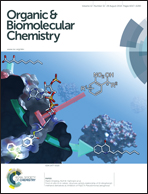1,1,1,3,3,3-Hexafluoro-2-propanol and 2,2,2-trifluoroethanol solvents induce self-assembly with different surface morphology in an aromatic dipeptide†
Abstract
Peptide based self-assembled structures, especially those from smaller peptides, have attracted much research interest due to their potential applications as biomaterials. These structures have been produced using different solvents (one of the methods), including alcohols, except fluorinated alcohols, which are believed to support non-aggregated structures. Herein, we have studied the ability of 2,2,2-trifluoroethanol (TFE) and 1,1,1,3,3,3-hexafluoro-2-propanol (HFIP) solvents to induce self-assembly of an aromatic dipeptide, namely Tyr–Phe (YF). SEM images showed that HFIP and TFE can induce self-assembly with completely different morphologies, namely microribbons and microspheres, respectively, when YF is dried on a glass surface. Optical microscopic images showed that the microribbons possess birefringence under polarized light, whereas the microspheres do not, indicating that the self-assembled structures derived from HFIP solution are more highly ordered and crystalline in nature than those derived from TFE. Spectroscopic results indicated that the YF peptide adopts completely different conformations in these solvents. Time-dependent experiments suggested that the conformation of YF in HFIP is kinetically unstable and undergoes conformational change, whereas it is more stable in TFE, demonstrating that the modes of interaction of the TFE and HFIP solvents with the peptide are dissimilar. Different self-assembled structures were observed at different time intervals when YF was incubated in neat HFIP and 10% HFIP–90% TFE, establishing that the monomeric conformation plays a dominant role in deciding the final self-assembled structure (morphology) of YF. The current results demonstrate that TFE and HFIP solvents can produce self-assembled structures with different morphologies during solvent evaporation, despite their similar properties, such as secondary structural (α-helix) induction and preserving the peptide in its monomeric conformation in solution.


 Please wait while we load your content...
Please wait while we load your content...